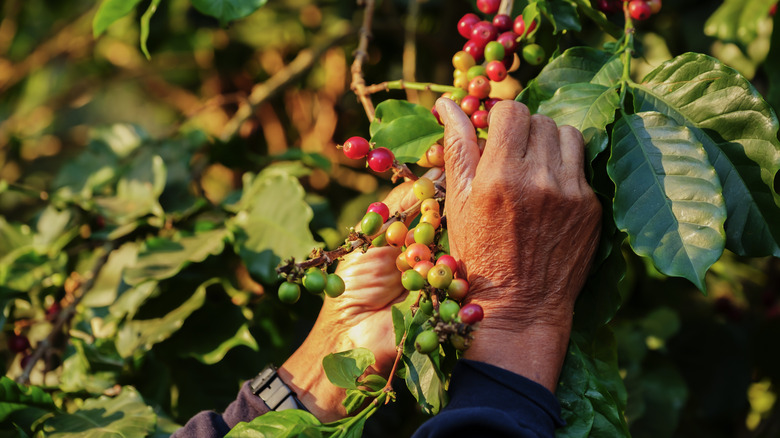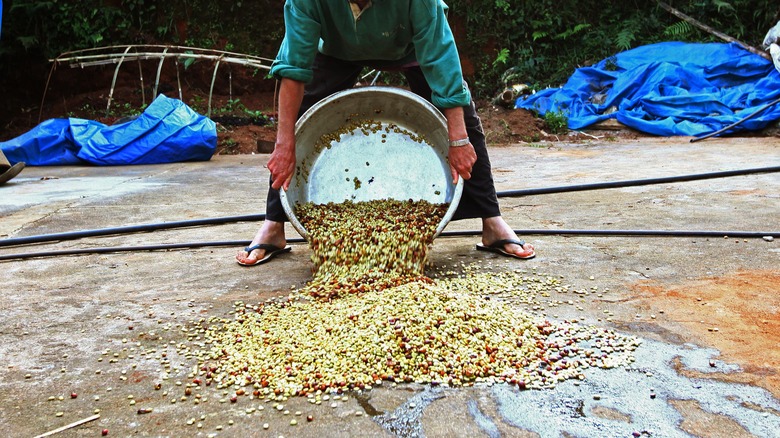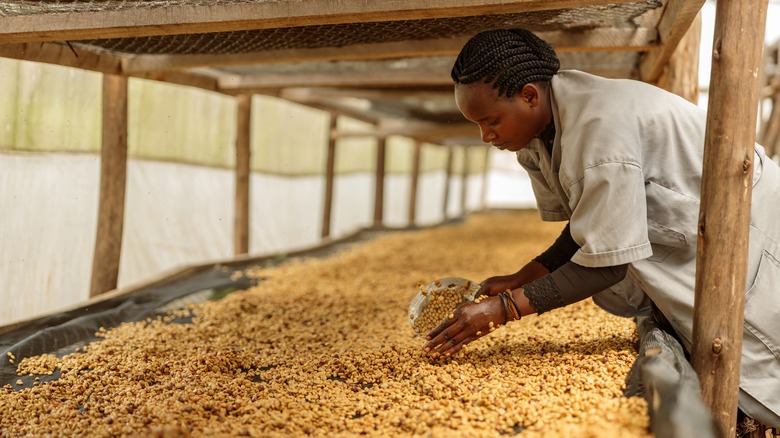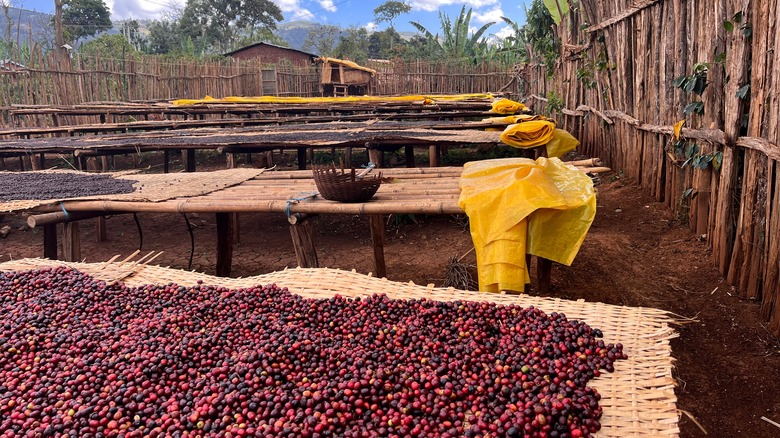Washed Vs Semi-Washed Vs Natural Process: What It Means For Your Coffee
For some, a cup of coffee is simply a daily pick-me-up, perhaps a tasty, but predominantly functional vessel for caffeine. Yet for more devoted fans, the beverage offers astounding complexity. After all, coffee packs in more flavor compounds than wine. In large part, such intricacy emerges due to the many factors that go into a cup, with each step distinctly influencing the flavor.
Especially prominent is the processing stage, which heavily impacts the coffee's palate, regardless of its origin and variety. You've likely seen the three principal styles listed on a bag of high quality coffee: washed, semi-washed, and natural process. The methods all accomplish the same task of taking off the cherry fruit and drying the bean. However, the specific mechanics each inspire a particular palate.
With natural coffees, the outer fruit is left adhered during drying, so resultant beans are more wild, fruity, and intensely aromatic. Meanwhile, washed coffees take off this pulp beforehand, inspiring a more balanced and gentle flavor. And semi-washed beans leave on a small mucilage layer, which lends more body and intensity. All such processing methods take place on the farm right after harvest, making them a strong influence on the product. So familiarizing with each style really aids in brewing, adding onto using the flavor notes on your bag of coffee.
Washed coffees remove fruit for the cleanest flavor
The washed process achieves the most standardized coffee, by means of removing the fruit prior to drying. It requires a lot of water — hence its alternate wet process name — which can be problematic for some producers, especially given climate change. After the coffee berries are harvested and sorted, the cherries are depulped through an industrial machine. A thin sticky mucilage layer remains, which is removed by fermenting the fruit in a tank for several days. Then, the result is washed once more, before drying begins.
It's a laborious process, however it pays off with clean and consistent coffee. What's contained in the bean is prominently showcased, helping you not only tell the difference between species like arabica and canephora, but also the production location, harvest year, and other qualities of terroir. Washed coffees enable savoring the details of a coffee, whether it's varietal grown in different locations, or the nuance of a micro lot.
So, when it comes to typical flavor, washed coffees pack in an extensive range. Oftentimes, there's a bit more acidity, as well as mild fruitiness, minerality, and some natural sweetness. Such a balanced and classic flavor made washed coffees the most popular type worldwide. Famed coffee-producing countries such as Kenya and Colombia have popularized their beans to global success upon such a processing method.
Semi-washed coffees keep some mucilage intact for added sweetness
The semi washed coffee process encompasses several substyles, each with their own nuances, but a generally similar approach. After harvest, a portion — if not most — of the fruit is removed, however a thin sticky layer of mucilage is left adhered to the bean. Such coffee is then dried, without the fermentation and rinse characteristic of the washed process. Just how much sweet substance is left on the bean separates it into its regional subtypes like honey coffee, popular in Central America, or pulped natural coffees innovated in Brazil.
The sticky sweet mucilage has a honey-like quality, hence such an alternate name. And it strongly influences the taste, with resultant cup's conveying more pronounced sweetness, lessened acidity, but still a clear display of the coffee's character. The flavor isn't overwhelmingly saccharine, but rather mingles with the bean's nuance, creating notes reminiscent of chocolate and dark fruit. The more mucilage is kept intact, the greater such an intensity, although there's also a risk of unwanted fermentation.
Such a sweet, yet complex and terroir-focused cup have made semi washed coffees esteemed by both producers and baristas. It's a recent innovation, only first practiced in Brazil a few decades ago, but is quickly spreading across growers in Latin America. There's lots of skill involved in selecting high-quality beans, timing the drying and avoiding over-fermentation. However, at the hands of a knowledgeable producer, the efforts impress with their delicious flavor.
Naturally processed coffees dry flesh-on for bold, fruity, and wild flavors
This method — also called the dry process — is the oldest and most hands-off. It involves the least human intervention, since the coffee fruit is picked off of the plant, and after some sorting and cleaning, immediately set out to dry. The cherries are laid out atop setups like raised tables, concrete, or patios, with direct sun exposure. As a result, more sugar undergoes fermentation, all the while the moisture evaporates over an extended duration.
Done well, natural coffees pack in vibrant notes that typically include fresh fruit, intense sweetness, and wine-like dryness. Some batches can taste palatably funky and exciting with bold, unusual flavors not found elsewhere. However, production comes at the risk of the coffee turning spoiled and moldy, through infection. And since the fruit rests out in the open air, there's further unpredictability due to factors like the humidity and rain, which can also impact the final flavor.
As a result, the fermentation-forward method places less emphasis on the bean's intrinsic qualities. The natural process makes it harder to appreciate what your coffee's source country tells you about its flavor. Nevertheless, some producers have mastered controlling all the factors, building upon a storied tradition. You'll often find natural coffees sourced from Ethiopia and Yemen — the plant's earliest cultivation regions — as well as Costa Rica and Brazil. And it's a candidate for micro lot coffees in other areas, lending an intriguing spontaneous nature to every batch.



